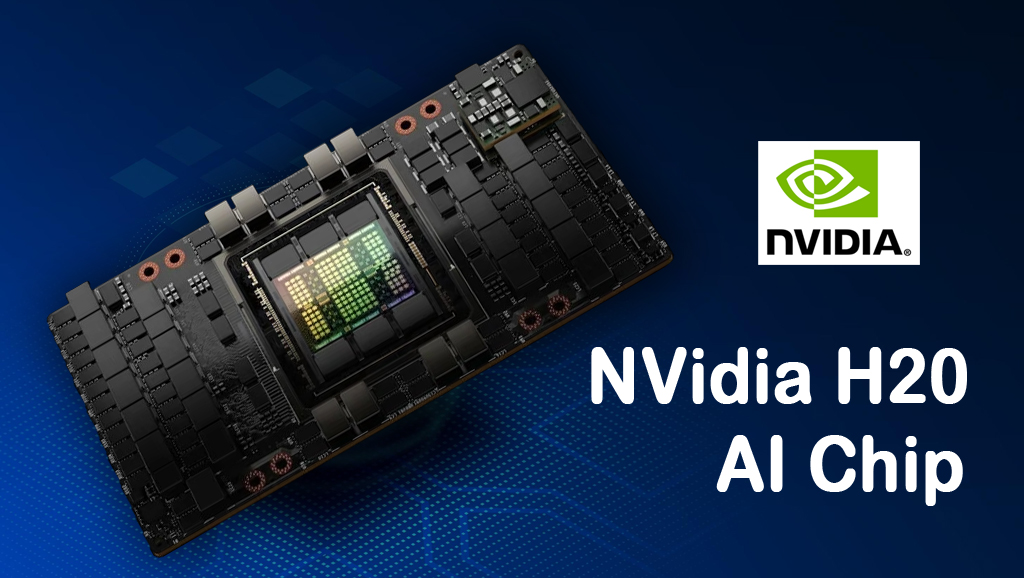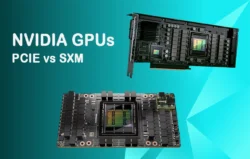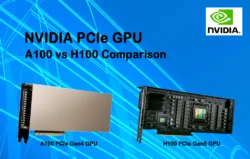Nvidia Corporation stands at the forefront of the artificial intelligence (AI) revolution, producing cutting-edge graphics processing units (GPUs) that power advanced AI applications. Among its latest offerings are the Nvidia H100 and H20 AI chips, which have garnered significant attention not only for their technical capabilities but also for their role in the complex geopolitical landscape, particularly in U.S.-China relations. This article provides a comprehensive overview of the Nvidia H20 AI chip, compares its features with the Nvidia H100, and explores why these chips are critical for China in the current era, especially in light of U.S. national security concerns that led to restrictions on their shipment and sales to China.
Table of Contents
Nvidia H100 AI Chip: Technical Excellence
The Nvidia H100 AI Chip, built on the Hopper architecture, is a flagship AI chip designed to handle the most demanding AI workloads, including training and inference for large language models (LLMs) like GPT-3 and Llama 2. Its advanced features make it a cornerstone of modern AI development:
- Performance: Offers up to 4X faster training for GPT-3 (175B parameters) compared to the previous generation, leveraging fourth-generation Tensor Cores and a Transformer Engine with FP8 precision.
- Inference Speed: Delivers up to 30X higher inference performance on large models, such as the Megatron chatbot (530B parameters).
- Memory Bandwidth: Provides 3TB/s per GPU, with the H100 NVL variant offering up to 30X higher aggregate system memory bandwidth compared to the fastest servers.
- GPU Memory: Available in 80GB (H100 SXM), 94GB (H100 NVL), and up to 188GB HBM3 memory, enabling support for LLMs up to 70B parameters.
- Interconnect: Features NVLink with 900GB/s (SXM) or 600GB/s (NVL) and PCIe Gen5 at 128GB/s for high-speed data transfer.
- Security: Includes confidential computing with a hardware-based trusted execution environment (TEE), a first for accelerators, ensuring data security during processing.
- Enterprise Utilization: Supports Multi-Instance GPU (MIG) with up to 7 MIGs at 10GB (SXM) or 12GB (NVL) each, allowing efficient resource sharing.
- AI Software: Comes with a 5-year Nvidia AI Enterprise subscription and Nvidia NIM for generative AI deployment.
- Thermal Design Power (TDP): Configurable up to 700W (SXM) or 350-400W (NVL).
- Decoders: Equipped with 7 NVDEC and 7 JPEG decoders for enhanced video analytics.
These specifications of Nvidia H100 position it as a powerhouse for AI research, high-performance computing (HPC), and data analytics, driving innovation across industries like healthcare, finance, and autonomous systems.
Nvidia H20 AI Chip: Tailored for Compliance
The Nvidia H20 AI chip is a specialized GPU developed specifically for the Chinese market to comply with U.S. export controls. Introduced after tightened restrictions in October 2023, the H20 is a downgraded version of Nvidia’s high-performance chips, such as the H100, with reduced computational power and memory capacity to meet regulatory requirements. While detailed specifications are less publicly available, key characteristics include:
- Purpose: Designed to allow Nvidia to maintain a presence in the Chinese market, which accounted for 13% of its revenue ($17 billion) in the fiscal year ending January 26, 2025, while adhering to U.S. export restrictions.
- Performance: Less powerful than the H100, with reduced computational density and interconnect speeds, making it suitable primarily for AI inference tasks rather than intensive training.
- Memory: Likely has significantly lower memory capacity than the H100’s 80-188GB, though exact figures are not disclosed.
- Interconnect: Retains NVLink connectivity at 900GB/s and supports 7-way MIG functionality, but performance is scaled down to comply with export controls.
- Applications: Optimized for cloud-based AI inference, virtual assistants, medical AI, autonomous driving, and financial AI applications, offering H100-class performance at lower power consumption and cost.
- Price: Priced between $12,000 and $15,000, competitive with Huawei’s Ascend 910B ($16,900), reflecting its cost-effective approach for the Chinese market.
The H20’s development reflects Nvidia’s strategic response to U.S. regulations that began in 2022, which restricted Chinese access to Nvidia’s top-tier AI processors. Despite its limitations, the H20 remains a critical asset for Chinese companies like Tencent, Alibaba, and ByteDance, particularly for inference tasks in AI models like DeepSeek’s R1.
Comparison Table: Nvidia H100 vs. H20
| Feature | Nvidia H100 | Nvidia H20 |
|---|---|---|
| Architecture | Hopper | Modified Hopper (downgraded) |
| Performance | 4X training, 30X inference (e.g., GPT-3) | Lower, optimized for inference |
| Memory Bandwidth | 3TB/s per GPU | Reduced |
| GPU Memory | 80GB/94GB/188GB | Likely <80GB |
| Interconnect | NVLink 900GB/s (SXM), 600GB/s (NVL) | NVLink 900GB/s, scaled down |
| Security | Confidential computing with TEE | Likely similar but less advanced |
| AI Workloads | Training and inference for LLMs | Primarily inference for LLMs |
| Target Market | Global | China (export-controlled) |
| TDP | 700W (SXM), 350-400W (NVL) | 400W |
| Price | $25,000-$40,000 (est.) | $12,000-$15,000 |
Importance in the Current Era
1. Role in Advancing AI Technology
AI chips like the H100 and H20 are pivotal for the development and deployment of modern AI applications, including natural language processing, generative AI, autonomous vehicles, and scientific research. The H100’s high performance enables researchers and companies to train and deploy massive LLMs efficiently, accelerating innovation in fields like healthcare, finance, and robotics. The H20, while less powerful, supports AI inference tasks critical for deploying AI models in production environments, making it valuable for Chinese firms restricted from accessing more advanced chips.
2. Geopolitical Significance
The U.S.-China technology rivalry has placed AI chips at the center of a strategic competition. The U.S. views advanced AI technology as a national security asset, fearing that its use in China could enhance military capabilities or challenge U.S. technological leadership. The H20 was developed to balance Nvidia’s business interests with these restrictions, but its role remains contentious. For instance, Chinese companies like DeepSeek have used H20 chips to develop advanced AI models, raising concerns among U.S. lawmakers about their potential impact.
3. National Security and Export Controls
Since 2022, the U.S. has imposed stringent export controls on advanced AI chips to China, citing risks of military applications. The Biden administration tightened these restrictions in 2023, and in April 2025, the Trump administration required export licenses for the H20, effectively halting its sales. However, following negotiations and a meeting between Nvidia CEO Jensen Huang and U.S. officials, the U.S. government reversed this stance in July 2025, allowing H20 sales to resume as part of broader trade talks involving rare earths. This decision sparked criticism from lawmakers like John Moolenaar, who argued that even downgraded chips could bolster China’s AI capabilities, potentially narrowing the U.S. lead.
The H20’s significance is underscored by its use in Chinese supercomputers, which may violate U.S. export controls if used for restricted purposes. For example, Tencent and DeepSeek have reportedly used H20 chips in facilities training large AI models, raising concerns about compliance with U.S. regulations.
4. Economic and Market Implications
China is a critical market for Nvidia, contributing $17 billion (13% of total sales) in the fiscal year ending January 26, 2025. The H20’s availability allows Nvidia to maintain its market share in China, where it previously held over 90% of the AI chip market. However, competitors like Huawei, with its Ascend 910B chip, pose a growing challenge, especially as Chinese firms seek alternatives amid export uncertainties. The H20’s competitive pricing ($12,000-$15,000) compared to Huawei’s offerings helps Nvidia retain its dominance, but the company is also developing a new Blackwell-based B30 chip for China, expected to be 10-20% slower but 30-40% cheaper than the H20.
5. Broader Implications
The restrictions on AI chip exports highlight the growing divide in the global AI ecosystem. While the U.S. aims to maintain its technological edge, China is investing heavily in indigenous AI chip development, potentially reducing reliance on Nvidia’s products. The H20’s role in this dynamic illustrates the challenges tech companies face in navigating geopolitical tensions while pursuing global market opportunities. The ongoing debate over export controls also raises questions about balancing economic interests with national security, as evidenced by the $5.5 billion charge Nvidia recorded in April 2025 due to restricted H20 exports.
Conclusion
The Nvidia H100 and H20 AI chips represent the pinnacle of AI hardware technology, with the H100 driving global AI innovation and the H20 serving as a critical, albeit restricted, solution for the Chinese market. Their significance extends beyond technical capabilities to encompass national security, international trade, and the global race for AI dominance. As the U.S. and China continue to compete in this strategic domain, the H20’s role as a compliant yet capable chip underscores the delicate balance between technological advancement and geopolitical strategy. The evolving landscape of AI chip exports will likely shape the future of AI development, with implications for both innovation and global power dynamics.







